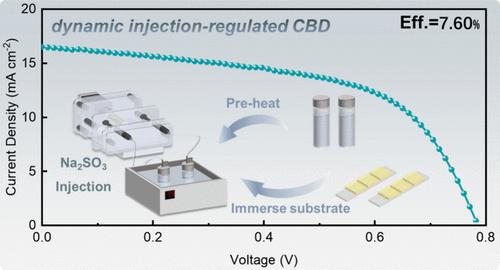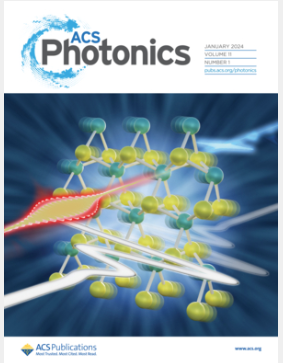Dynamic Injection-Regulated Growth Kinetics of Sb2S3 Films for High-Efficiency Solar Cells
IF 6.7
1区 物理与天体物理
Q1 MATERIALS SCIENCE, MULTIDISCIPLINARY
引用次数: 0
Abstract
Antimony sulfide (Sb2S3) is a promising solar abosrber due to its excellent optoelectronic properties. However, efficiency improvements are hindered by a limited understanding of complex reaction mechanisms in solution-based deposition, particularly the unclear dynamic evolution of the ionic environment during sulfur-source decomposition. To address this, we modified conventional chemical bath deposition (CBD) by dynamically injecting sodium sulfite (Na2SO3) using a programmable peristaltic pump. This strategy achieved precise control over the release kinetics of S2– and Sb3+, yielding denser Sb2S3 films with enhanced crystallinity, reduced oxygen incorporation, and lower defect density. In full-inorganic FTO/TiO2/CdS/Sb2S3/PbS/graphite devices, the optimized dynamic injection approach delivered a power conversion efficiency (PCE) of 7.60%, surpassing the conventional CBD method (6.88%) and representing the highest reported value for Sb2S3 solar cells using graphite electrodes. Notably, all functional layers were synthesized via the inherently safe and tunable CBD process. This study elucidates Sb2S3 deposition kinetics and proposes a dynamic injection strategy with potential applications in doping control and bandgap engineering for broader chalcogenide materials.

高效太阳能电池用Sb2S3薄膜动态注入调控生长动力学研究
硫化锑(Sb2S3)具有优异的光电性能,是一种很有前途的太阳能吸收剂。然而,由于对溶液沉积中复杂反应机制的了解有限,特别是对硫源分解过程中离子环境的动态演变不清楚,阻碍了效率的提高。为了解决这个问题,我们通过可编程蠕动泵动态注入亚硫酸钠(Na2SO3)来改进传统的化学浴沉积(CBD)。该策略实现了对S2 -和Sb3+释放动力学的精确控制,生成了结晶度增强、氧掺入减少、缺陷密度降低的更致密的Sb2S3薄膜。在全无机FTO/TiO2/CdS/Sb2S3/PbS/石墨器件中,优化的动态注入方法的功率转换效率(PCE)为7.60%,超过了传统的CBD方法(6.88%),是使用石墨电极的Sb2S3太阳能电池的最高报告值。值得注意的是,所有功能层都是通过固有的安全和可调的CBD工艺合成的。本研究阐明了Sb2S3沉积动力学,并提出了一种动态注入策略,在更广泛的硫系材料的掺杂控制和带隙工程中具有潜在的应用前景。
本文章由计算机程序翻译,如有差异,请以英文原文为准。
求助全文
约1分钟内获得全文
求助全文
来源期刊

ACS Photonics
NANOSCIENCE & NANOTECHNOLOGY-MATERIALS SCIENCE, MULTIDISCIPLINARY
CiteScore
11.90
自引率
5.70%
发文量
438
审稿时长
2.3 months
期刊介绍:
Published as soon as accepted and summarized in monthly issues, ACS Photonics will publish Research Articles, Letters, Perspectives, and Reviews, to encompass the full scope of published research in this field.
 求助内容:
求助内容: 应助结果提醒方式:
应助结果提醒方式:


